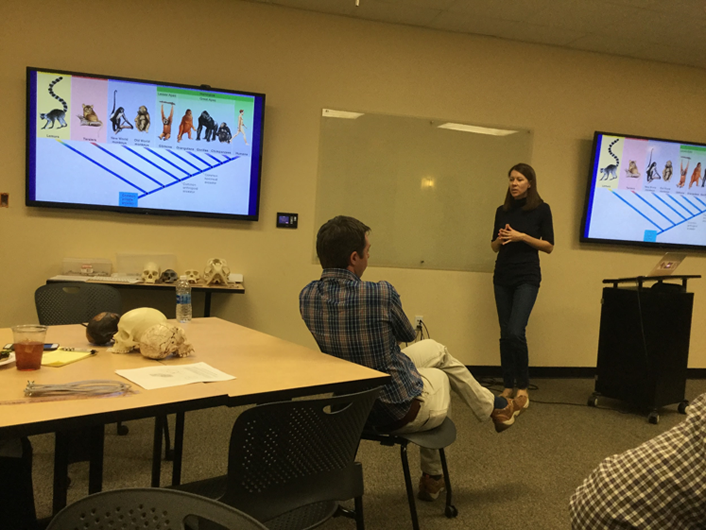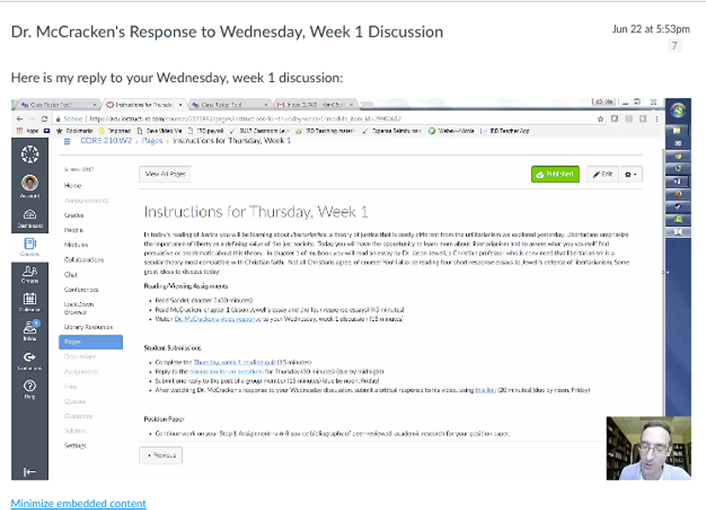Key Takeaways
-
However popular it might be, the nearly decade-old flipped classroom concept has proven a tepid alternative to face-to-face teaching.
-
The time is now ripe to flip the flipped classroom in favor of a new model that preserves the power of the in-class lecture, while incorporating technology and activities as a support rather than a substitute.
-
Video plays a key role in this new model as a tool for offering personalized, targeted feedback to students on individual and group assignments.
The flipped classroom model of teaching has been popular among educators around the world for about a decade, thanks both to faculty experimentation and the tremendous success of organizations such as Khan Academy, which make instructional videos available for teachers and students. This flipped model is built around recording lectures for consumption outside of class, with classroom time devoted to discussion and activities. The approach has been touted as transformative and disruptive to education as usual.
However, I do not see evidence of this model causing serious disruption to education. The model is not a strong alternative to face-to-face teaching, as online teaching sometimes is; further, those who claim to have "flipped" their classrooms are sometimes masquerading a blended learning experience as a flipped class.
It is time to flip the flipped classroom model, not in favor of a nostalgic return to teaching models of old, but rather in favor of a new model.
A New Model
This new model will focus on reinforcing classroom lectures with technology and active learning techniques, while individualizing student feedback in innovative ways.
Active Lectures
Good lectures should be restored and reinforced rather than replaced by video lectures. The flipped classroom started with the misperception that lecturing is ineffective and unappreciated. However, lecturing per se is rarely the problem, as Molly Worthen pointed out in her New York Times article.1
Bad lectures contribute to poor learning. Bad lectures are boring; bad lectures lack meaning and purpose; bad lectures lack understanding of students; and bad lectures are disconnected from learning objectives and assessments. If teachers lack interest in or insight into students and the learning process, introducing so-called active learning activities simply replaces boredom with chaos, making good old lecturing a relief in retrospect.
In addition to failing to understand the value of lectures, the flipped classroom fails to appeal to the intrinsic motivation of faculty members. Why would they forego their own live lecturing? Why would they spend time producing videos as if they were trained by Hollywood instead of Harvard? Why would they spend time adding "active learning" tricks if they know what makes or breaks a class?
In the flipped classroom model, teachers use class time for group work or active learning activities based on the rationale that doing so lets them give more individualized and immediate feedback to students. That does not always happen, however, as teachers cannot split themselves to give individualized attention to all groups or all individuals.
The good intention of individualized attention must face the harsh realities of limited teacher capacity; otherwise, what starts as active learning may dissolve into organized chaos, especially when group work is involved and students begin working together before they have gained a basic understanding of the material — thus becoming the blind leading the blind. Students' individual needs remain unmet in the wake of such experiences. Going home to watch generic lecture videos does not provide remediation, as such videos may not be produced to address individual issues.
Instead of restoring the practice of teachers talking during the entire class period, professors should intentionally incorporate what James Lang called "small teaching" techniques in the lecturing process. For instance, they might build into that process retrieving, predicting, and self-explaining activities.2 Further, faculty members can learn from each other about effective lecturing practices.
At Abilene Christian University (ACU), we appreciate good lectures and started a lunchtime series called My Best Lecture, in which we invite professors, usually rated highly by students, to give their favorite lecture to demonstrate their approach to fellow professors. My Best Lecture is one of our most popular faculty development programs. Teachers love to see each other lecture. It is an old art, but one that still has room for improvement. As our series has made clear, good lectures incorporate connections to prior learning, presentation of new content, questions and answers, verbal and physical cues, instructional humor, and many other components appreciated by students and faculty alike. That is, good lectures include components of active learning that the flipped classroom model is meant to promote. Rebecca Hunter, for example, an associate professor of biology at Abilene Christian University, uses rich presentation tools and artifacts in her lectures (figure 1).

Many useful technologies can guide professors and students. For instance, teachers can use Padlet — a virtual wall to post content without having to sign up — to gather quick feedback from students. Cassandra Sachar from Bloomsburg University recommends using quick polling and interaction apps such as Kahoots and sli.do during class to promote active lecturing.3 However, professors need not rely on "killer apps" for active learning activities; to gather feedback from students, Google Docs and discussion boards can be equally effective.
Video Feedback, Not Video Lectures
Instead of trying to replace lectures with videos, teachers can replace text-based feedback with video feedback. Students can complete their work individually or in groups before or after classes. Teachers can then give them feedback by recording "quick and dirty" (focus on "quick") videos commenting on their individual or group work. That is, rather than producing polished instructional videos to replace a lecture, teachers can produce informal videos to give individual feedback to students.
Videos, especially screencast videos, let teachers personalize their feedback to individual students in an environment where the teachers feel comfortable, whether their offices, studios, or even back yards. Teachers should nonetheless aim for the best possible lighting and sound, so students do not have to strain while watching videos that are barely audible or seem to have been shot in a cave. Being able to choose the location lets teachers relax, and the production is not nearly as stressful as producing reusable lecture videos.
Instructors can use such videos to give quick feedback, work through problems, explain graphics or diagrams, or elaborate on structures. Tools such as Camtasia, Jing, Screencast-o-matic, Quicktime, Explain Everything, or Showme are all fairly easy to use for producing short feedback videos. Substantial research has proven this "veedback" (for video feedback) approach to be both effective and popular among students. Indeed, learning management systems (LMSs) such as Canvas now allow teachers to comment with media rather than text alone. Instructors can simply record media comments and then upload them to their LMS, or record a short media comment using the LMS's own media tools. In figure 2, Tracy Spencer, adjunct professor of education at ACU, uses video to give feedback on a student's assignment. In figure 3, Vic McCracken, associate professor of Bible, missions, and ministry at ACU, uses video to offer feedback on student discussions.


Using videos for feedback will also save teachers time. Offering comments verbally in a video is faster than typing, letting instructors say more in the same amount of time. When grading assignments, try talking to the students during the video — address them by name, give specific suggestions, offer encouragement or confirmation, and guide them toward a better draft. While talking-head videos are taboo in online lecturing, I have found that students do not mind a talking head if the head is addressing them directly. That said, if you need to demonstrate something on the screen, it is better to produce screencast videos capturing screen activities as you narrate.
Concluding Thoughts
I have seen many of our professors' video feedback sessions; sometimes they include unexpected interruptions, such as children, ringing phones, or the family dog wandering into the frame. Sometimes I hear the sound of dinner being prepared or a lawn being mowed in the background. So what? Teachers are human, too, and students will appreciate the richness of their lives. Let your teachers offer video feedback that is casual and authentic. Let them focus on content, rather than fancy transitions and eye-candy effects. And, when they return to the classroom, allow them to be the sage on stage — just the way they, and students, like it.
Notes
- James M. Lang, Small Teaching: Everyday Lessons from the Science of Learning, Jossey-Bass, 2016.
- Molly Worthen, "Lecture Me. Really," New York Times, October 17, 2015.
- Cassandra O'Sullivan Sachar, "I'm in 'Kahoots' with Technology in the Classroom," Faculty Focus, July 31, 2017.
Berlin Fang is director of Instructional Design, Walter H. Adams Center for Teaching Excellence, Abilene Christian University.
© 2017 Bailin (Berlin) Fang. The text of this article is licensed under Creative Commons BY-NC-ND 4.0.
